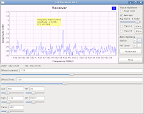I was fooling around with the USRP / WBX on the 2 meter band tonight when I suddenly stumbled upon some very strong SSTV transmission. It turned out to be the OZ9STV robot located only a few kilometers from me. That explained why I had more than 40 dB SNR even though I was only using a bad whip antenna indoors.
Month: April 2010
UNITEC-1 5.8 GHz Receiver Test Using OZ7IGY
![]()
Tuesday, April 13, 2010 we finally got a chance to test the 5.8 GHz receiver for the UNITEC-1 ground station on the air. The weather was nice and the weak wind allowed us to be on the roof and listen for the OZ7IGY beacon 40 km away.
GNU Radio SSB/CW/AM/FM Receiver v0.6
New update of the simple receiver – version 0.6 – with the following changes:
- Added frequency entry widget to change USRP frequency
- Also created AM and narrow FM versions
Binaural CW Receiver with GNU Radio and USRP
Today I felt like doing an experiment that is not quite on my TODO list – a binaural CW receiver. A binaural CW receiver is a receiver that gives a spatial feeling while you are tuning. As I understand it, you have to use stereo where the signals move from one side to the other as you tune and are in the middle when you are tuned to the frequency.
Frequency xlating filter vs. complex multiplication
When I upgraded the simple GNU Radio receiver to single side band, I decided to separate the band pass filter and the frequency xlating filter and the frequency xlating filter got equipped with a wide low pass filter instead. The low pass filter is useful but really not important. Therefore, I decided to replace the frequency xlating filter with a simple complex multiplication (aka. local oscillator) and thereby save some CPU cycles – I figured that removing a filter would save something.
Improved AGC for the simple SSB receiver
Few days ago I wrote about how I upgraded the simple double side band receiver implemented in the GNU Radio Companion to a simple single side band receiver. This initial implementation used some default values for the AGC attack and decay rates. These values were acceptable; however, I wanted to spend some time trying to find better values that would correspond to Fast, Medium and Slow AGC – just as we are used to in commercial radios.
Simple SSB Receiver in GNU Radio Companion
The simple SSB software defined radio receiver is now functional!
Few days ago I wrote about how to upgrade the simple double side band receiver to single side band. The modification was supposed to be very simple and involved changing the band pass filter from using real taps to use complex taps. The upgrade wasn’t quite as easy, though.
The Butternut HF2V antenna after three years
More than three years ago that I have mounted my Butternut HF2V multi-band vertical antenna outside and left it suffer from the windy and humid Danish climate. The settings and performance that I could achieve back then are documented in several blog posts, e.g.Tuning the Butternut HF2V.
What has happened with the Butternut HF2V since then? Well, nothing really… During these three years, the antenna has been standing and performing very well without any need for fixing or tuning it. I have done a visual inspection and tightened the guy ropes every now and then, but that’s all. In order to document it I have taken a few photos and made some SWR scans.
From double side band to single side band reception
 When I presented the Simple CW Receiver few weeks ago I also mentioned and demonstrated that it is actually a double side band receiver (it’s around 2:35 in the video). This is good for AM and FM, but can be very inconvenient for receiving CW and SSB (single side band). If the station we are trying to receive is surrounded by other stations on the neighbouring channels, these will interfere via the opposite side band. Therefore, it was time to look into single side band reception.
When I presented the Simple CW Receiver few weeks ago I also mentioned and demonstrated that it is actually a double side band receiver (it’s around 2:35 in the video). This is good for AM and FM, but can be very inconvenient for receiving CW and SSB (single side band). If the station we are trying to receive is surrounded by other stations on the neighbouring channels, these will interfere via the opposite side band. Therefore, it was time to look into single side band reception.